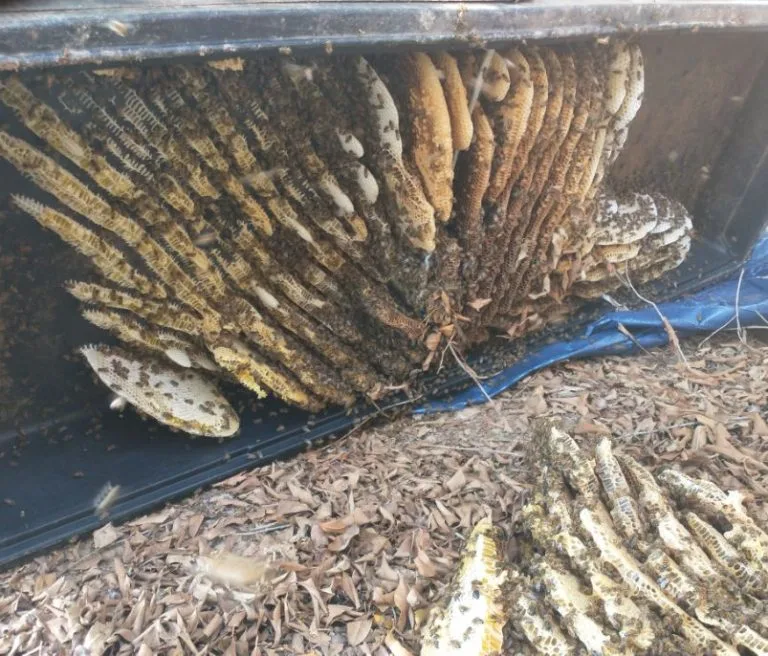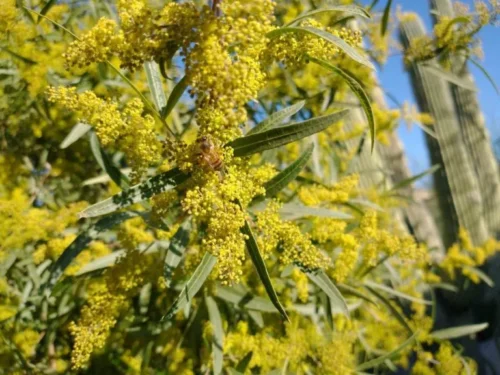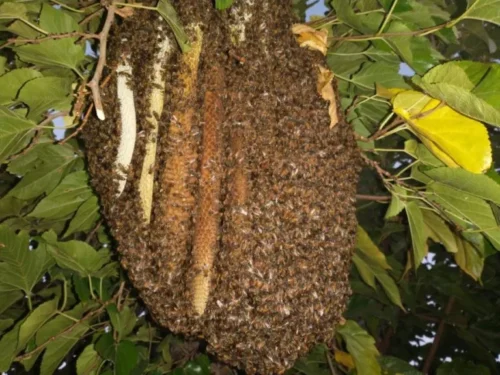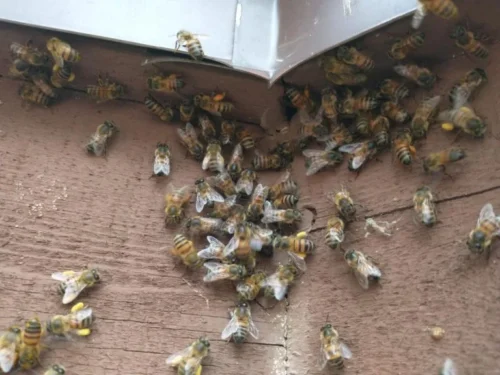
In February 2022 Phoenix bee removal and health is normally just starting to increase because the coldest months of December and January are behind us. The same situation exists for Phoenix bee removal and Mesa bee removal. The level of activity varies between bee colonies depending on daytime high temperatures, colony population, stored food supply, and availability of blooming plants.
We specialize in live bee removal aka humane bee removal. We catch and release or re-hive bees at a new location away from conflict with human activity. This is because, like you, we value honeybees and all pollinators. The photo below shows a Scottsdale live bee removal job we performed in February.
The Africanized honeybee is an excellent pollinator and more than 90 percent of feral honeybees colonies in the Phoenix area are Africanized.
RAINFALL DRIVES PHOENIX BEE REMOVAL AND HEALTH
Rainfall is the number one factor that drives the need for Scottsdale bee removal. Scottsdale and surrounding cities had a good monsoon season in 2021 and it caused blooming flowers on purple sage and other plants attractive to bees. This in turn allowed bees to collect and store critically-needed pollen and nectar. With this stored food, more small bee colonies survived this fall and winter rather than starving to death.
Fall and winter rain is the single most important factor influencing the quantity of bee swarms our customers will have this spring and summer. More rain means more bee swarms. Why does this happen? Because rain causes the germination and growth of the two most important plants that provide early-season bee feed: wild mustard and malva weed. The African sumac tree is more a more reliable source of bee feed this time of year. The photo below shows a bee gathering pollen and nectar from an African sumac tree.

It takes a minimum of three rainfall events extending over approximately two month to grow these plants. As a result of several rains starting in December 2021, we are starting to see blossoms appearing on wild mustard. Malva weed is also growing and just starting to bloom.
DAYTIME HIGH TEMPERATURES
For best bee colony growth during our coolest fall and winter months, bees need at least 50% of days with daytime high temperatures of at least 68 degrees Fahrenheit. This is the minimum temperature at which bees have enough “flying time” to gather food. In the photo below, the bees are carrying yellow and orange pollen.
We have experienced winters where bee colonies shrunk and spring swarm counts were low despite large amounts of blooming flowers. This happened because the majority of daytime high temperatures were 64 degrees or below. We carefully monitor these factors so that we can forecast our staffing and equipment needs to best serve our Scottsdale bee removal customers.
COLONY POPULATION
During fall, winter, and early spring, survival is uncertain for bee colonies with bee populations of 5,000 bees or less. This size bee colony has just enough bees to fly for food and water, make honeycomb, care for baby bees, and regulate hive temperature. If there aren’t many blooming flowers available, small bee colonies are at risk of population shrinkage and shortly thereafter, death.

Medium size colonies generally avoid starvation if blooming plants become plentiful before March. But in years of very low rainfall, even medium size colonies may starve to death.
Large colonies generally coast through the fall and winter because they are able store adequate food supply and raise replacement worker bees to bring in new food. Success of a bee colony is all about having enough population to gather food so that they make baby bees to replace old bees as they die off.
HONEYBEES RESPOND TO SEASONAL CUES
The amazing honeybee is very tuned to its environment. An environmental cue instinctively noticed by bees is the December 21 winter solstice. It is the shortest day of the year. Each day past December 21, daylight hours increase by a few minutes. Bees notice the very tiny increase in daylight hours, and if they have adequate stored food or blooming plants to provide food, they begin to raise babies (brood). The pace of the queen bee’s egg laying will be faster as more food is available and slower if less food is available. To avoid starvation, bees conserve food by raising less babies during times of limited food intake. When there are a lot of plants and trees blooming in the spring, bees maximize their raising of baby bees. This is how bees conserve their food to avoid starvation or use food go grow their colony population.

PHOENIX BEE REMOVAL AND HEALTH FORECAST
Based on our observations of honeybee colony health, rainfall, and plant growth, we anticipate phoenix bee removal and health will be better than average and the number of bee swarms will be higher in 2022. Plant bloom resulting from last year’s monsoon rains contributed to ample winter food stores in most bee colonies. This year, most honeybee colonies have been able to conserve stored-food supplies because warm winter temperatures have allowed for enough flying time to maintain food stores. Also, bees have not had to consume much food to stay warm because outdoor temperatures have been warmer than normal. Rains starting in early December have caused primary bee feed plants to grow and they are already beginning to bloom. Adequate food supply is great news for the health of our very important honeybee. However, it increases the chance that you will need Scottsdale bee removal, Chandler bee removal, or Gilbert bee removal this year.
Call The Beekeeper Total Bee Control for all your Scottsdale bee removal, Phoenix bee removal, and Mesa bee removal needs. We serve Maricopa, Pinal, Pima, and Yavapai counties. We look forward to serving you!
